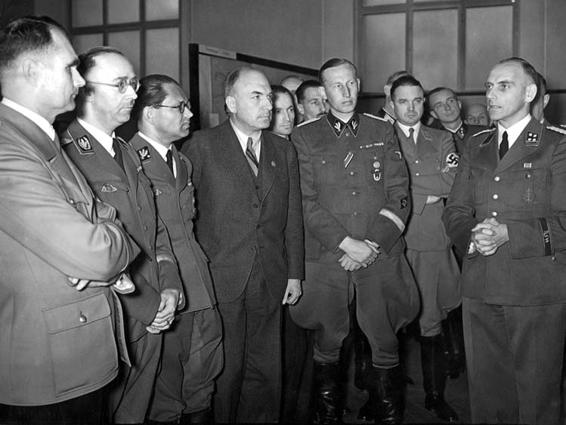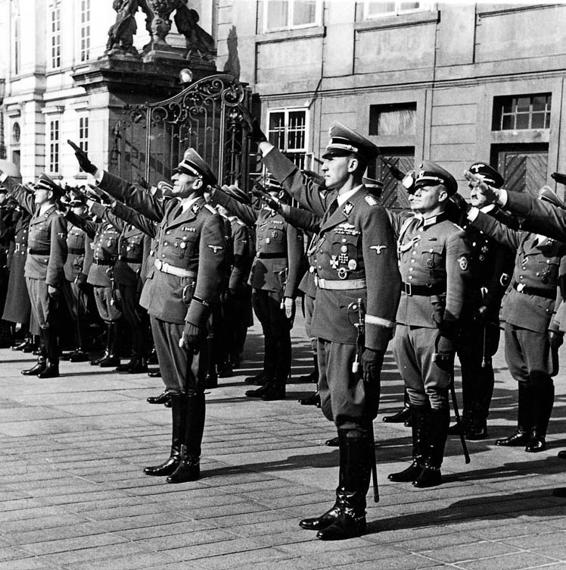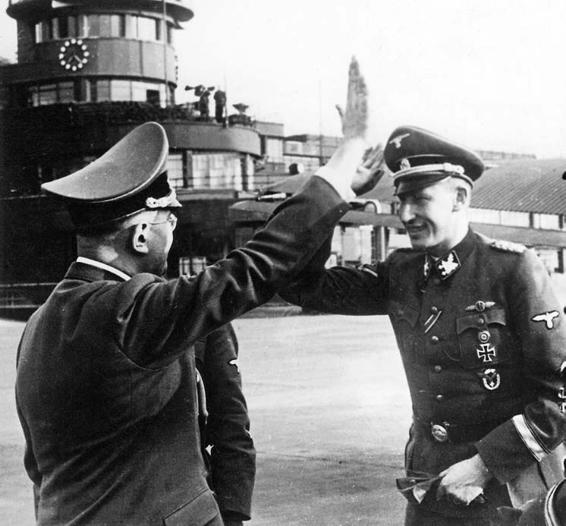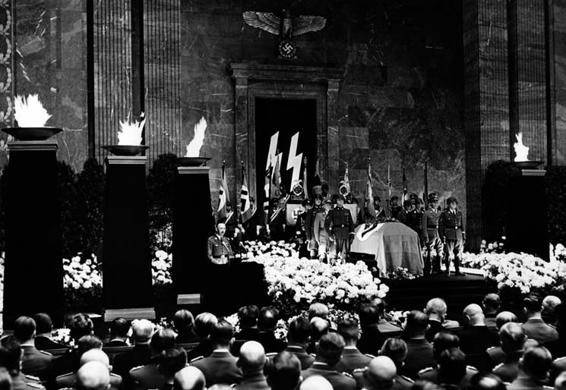Hitler's Hangman (3 page)

16 Heydrich and Göring at the latter’s birthday reception in January 1941. Göring and Heydrich
had a troubled relationship at first, but became close collaborators on Nazi anti-Semitic policies
after Kristallnacht. It was Göring who authorised Heydrich to prepare a ‘total solution of the
Jewish question’.

17 Rudolf Hess, Himmler (first and second left) and Heydrich (centre) listen attentively as
Professor Konrad Meyer explains his plans for German settlement in the East, March 1941.
Meyer’s General Plan East was designed to provide a road-map for the ethnic reordering of Eastern
and Central Europe and played a major role in Heydrich’s thinking on Germanization policies.

18 Heydrich saltues the SS flag as it is raised over Prague Castle on his arrival in September 1941.
As acting Reich Protector of Bohemia and Moravia, Heydrich successfully suppressed the Czech
opposition through rigorous persecution and instigated racial policies designed to Germanize the
Protectorate of Bohemia and Moravia

19 Heydrich greets his former adjutant, Carl Albrecht Oberg, on his arrival in Paris where he
installs him as the new higher SS and police leader in France, May 1942. Oberg was the first
higher SS leader in France, marking a major breakthrough for the SS whose power had previously
been largely confined to Germany and the occupied East. This was Heydrich’s last journey. One
month later, he was dead.

20 An emotional Himmler speaks at Heydrich’s funeral in Berlin. It was the largest state funeral
held in Nazi Germany during the war and attended by Hitler and virtually every influential figure
in the Third Reich.
Preface
How does one write the biography of Reinhard Heydrich, one of the key
players in the most murderous genocide of history, a historial figure the
Nobel Laureate Thomas Mann famously referred to as Hitler’s ‘hangman’?
This is the question I have been asking myself from the moment I first
decided to embark on this book project. It was always clear to me that
the writing of a Nazi biography would pose a specific set of challenges,
ranging from the need to master the vast and ever-growing body of
literature on Hitler’s dictatorship to the peculiar problem of having to
penetrate so the mind of a person whose mentality and ideological
universe seem repellent and strangely distant, even though the Nazi dicta-
torship ended less than seventy years ago. But the major challenge lay
elsewhere: namely, in the fact that any kind of life-writing requires a
certain degree of empathy with the book’s subject, even if that subject is
Reinhard Heydrich.
Biographers often use the contrasting images of autopsy and portrait
to describe their work: while the autopsy offers a detached, forensic
examination of a life, the portrait relies on the biographer’s empathy
with his subject. I have chosen to combine both of these approaches in a
third way best described as ‘cold empathy’: an attempt to reconstruct
Heydrich’s life with critical distance, but without reading history back-
wards or succumbing to the danger of confusing the role of the historian
with that of a state prosecutor at a war criminal’s trial. Since historians
ought to be primarily in the business of explanation and contextualization,
not condemnation, I have tried to avoid the sensationalism and judge-
mental tone that tend to characterize earlier accounts of Heydrich’s
life. Heydrich’s actions, language and behaviour speak for themselves, and
wherever possible I have tried to give space to his own characteristic voice
and choice of expressions.
P R E FAC E
xi
Personal records, however, are scarce in Heydrich’s case. I have searched
the relevant archives in Germany, Britain, the United States, Russia, Israel
and the Czech Republic and that search has revealed many more sources on
Heydrich’s life than are often assumed to exist. Yet unlike Joseph Goebbels
or the young Heinrich Himmler, Heydrich did not keep a personal diary
and only fragments of his private correspondence have survived the Second
World War. However there exists a remarkably large body of official docu-
ments, speeches and letters, which al ow us to reconstruct his daily routines
and decision-making processes in great detail.
In identifying the widely dispersed source material on which this book
is based, I frequently had to rely on the helpful advice of archivists and
librarians. I am very grateful for the expert assistance of the staff of several
archives and libraries across the globe that have given me access to their
extensive holdings and supplied me with unpublished material. These
include the Institut für Zeitgeschichte in Munich, the German Federal
Archives and its various branches in Berlin, Koblenz, Freiburg and
Ludwigsburg, the British and Czech National Archives in Kew and
Prague; the archives of Yad Vashem in Jerusalem and the Holocaust
Memorial Museum in Washington DC, as well as the German Historical
Institute in Moscow which greatly facilitated my access to the Reich
Security Main Office files in the Osobyi Archive.
This book originated in Oxford and I remain deeply indebted to many
friends and former col eagues there. Martin Conway and Nicholas
Stargardt advised on this project at various stages and provided most
welcome criticism on earlier drafts of the book. Roy Foster taught me a
great deal about life-writing, has offered bril iant comments on the manu-
script and has remained a friend and inspiration beyond my time in
Oxford. Since leaving Oxford in 2007, I have become a staff member of
University Col ege Dublin, which has given me remarkable freedom to
research and to write. Among my col eagues at UCD, Wil iam Mul igan,
Stephan Malinowski and Harry White have been most helpful critical
readers and sources of encouragement. Apart from my col eagues at UCD’s
Centre for War Studies, I must also thank John Horne of Trinity Col ege
Dublin for three years of happy research col aboration and for being a
constant inspiration in his dedication to historical scholarship.
Outside Oxford and Dublin, Nikolaus Wachsmann, Chad Bryant,
Mark Cornwall and Jochen Boehler generously agreed to read drafts of
my work, as did two anonymous readers who went far beyond the call of
duty in commenting on my original ideas. Their suggestions have greatly
enhanced the final manuscript and I am immensely grateful to them.
In Prague, I was fortunate to work with Miloš HořejŠ whose ability
to translate key sections of relevant Czech literature and sources has
xii
PREFACE
allowed me to incorporate the important work on the Nazi occupation of
Bohemia and Moravia that has been published in Czech over the past two
decades. In Berlin, I had the pleasure of working with Jan Bockelmann
whose diligence in compiling vast quantities of German sources and
literature has greatly aided the timely completion of this study. He and
Wolf Beck also did an expert job in providing the two maps in this
volume, while Seumas Spark helped with the index. Heather McCallum
commissioned this book some six years ago and she and her colleagues at
Yale University Press accompanied the production process with great
enthusiasm, competence and patience. It is difficult to imagine a better
publisher.
My final thanks, as always, go to my family. During my regular archival
trips to Berlin, my parents, Michael and Evelyn Gerwarth, provided
unfailing support, love and encouragement, for which I cannot thank
them enough. Finally, my debts to my wife, Porscha, are enormous. She
has read the manuscript from start to finish, and had to live with my
periodic absences and constant distraction over the past five years.
Dedicating this book to her is a necessarily inadequate attempt to
acknowledge the depth of my love and gratitude.
Dublin, May 2011
Introduction
Reinhard Heydrich is widely recognized as one of the great
iconic vil ains of the twentieth century, an appal ing figure even within the
context of the Nazi elite. Countless TV documentaries, spurred on by the
fascination with evil, have offered popular takes on his intriguing life, and
there is no shortage of sensationalist accounts of his 1942 assassination and
the unprecedented wave of retaliatory Nazi violence that culminated in the
vengeful destruction of the Bohemian vil age of Lidice. Arguably the most
spectacular secret service operation of the entire Second World War, the
history of Operation Anthropoid and its violent aftermath has inspired the
popular imagination ever since 1942, providing the backdrop to Heinrich
Mann’s
Lidice
(1942), Bertolt Brecht’s
Hangmen Also Die
(1943) and
Laurent Binet’s recent Prix Goncourt-winning novel
HHhH
(2010).1
The continuing popular fascination with Heydrich is easily explained.
Although merely thirty-eight years old at the time of his violent death in
Prague in June 1942, he had accumulated three key positions in Hitler’s
rapidly expanding empire. As head of the Nazis’ vast political and
criminal police apparatus, which merged with the powerful SS intelli-
